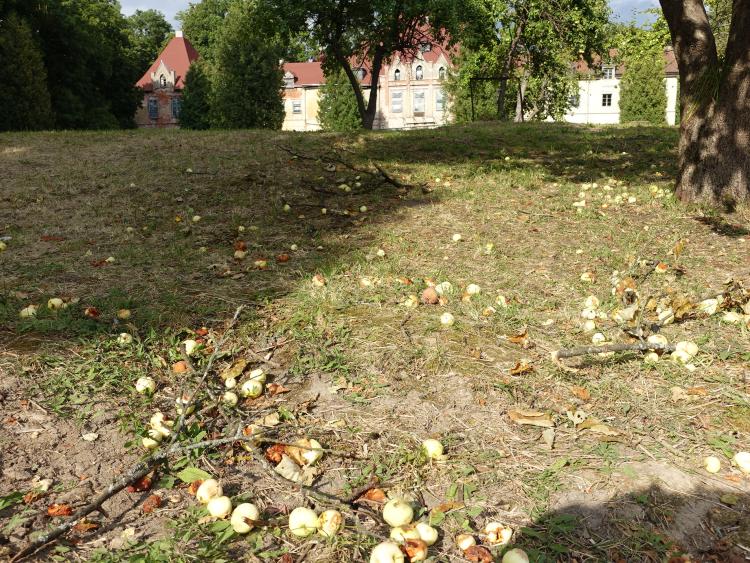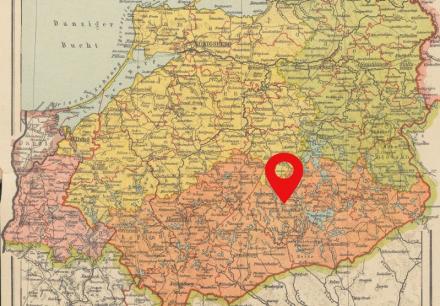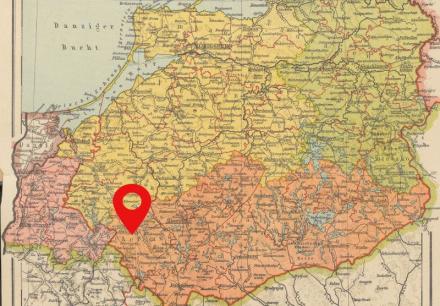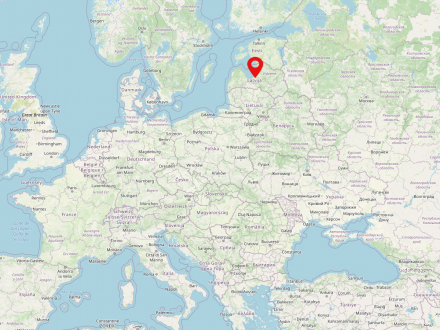A summer apple. The first to ripen. In Polish, it is called "papierówka", in German "Papierapfel" (paper apple). It once grew almost everywhere in Masuria and Warmia, including in the garden of Stefan Tymiec's grandmother, Gertrud. "It smelled and tasted delicious," he remembers. "And that yellow!" For his 60th birthday, he brought seedlings from a Polish nursery all the way to Wuppertal.
The migration of an apple variety
Text
The little trees that Stefan Tymiec bought on that nostalgic occasion are now six meters high. He prefers to eat them fresh from the tree, just as he did in his childhood days in . Or as apple compote, with “flinsen”, the small pancakes that were a culinary tradition of East Prussia.1
Kossewen
deu. Rechenberg
Kosewo ist ein Dorf am Jezioro Probarskie (Probergsee) in der polnischen Woiwodschaft Ermland-Masuren, das 1546 als „Kossewen“ gegründet wurde. Von 1938 bis 1945 hieß es Rechenberg (Ostpr.) 2011 hatte Kosewo knapp über 400 Einwohner:innen.


$de=Stefan Tymiec in seinem Wuppertaler Garten. Ulla Lachauer, Free access - no reuse
$de=Stefan Tymiec in seinem Wuppertaler Garten. Ulla Lachauer, Free access - no reuse
Text
The apple trees had been "inherited" by the settlers after 1945 – like so many things – from their expelled predecessors. They did not use their German name, "Augustäpfel” (August apples), but called them, as is customary in Poland, "Papierówki". Most of the trees must have been young at that time, because in the bitterly cold winter of 1928/29, with temperatures plummeting to 42 degrees below zero, almost all the fruit trees froze to death. After that, everything had to be started again from scratch – an enormous effort for the benefit of future generations.
As a boy, Stefan Tymiec (born in 1950) had plenty of opportunities to pick fruit. In the gardens of his friends and on abandoned plots of land that nobody used. Or in in Warmia, where his grandmother came from. There, shortly after the end of the war, an uncle had planted saplings that he had taken from an abandoned tree nursery. The owner had fled from the approaching Red Army.
As a boy, Stefan Tymiec (born in 1950) had plenty of opportunities to pick fruit. In the gardens of his friends and on abandoned plots of land that nobody used. Or in
Kajkowo
deu. Buchwalde
Kajkowo is a village on the Jezioro Sajmino, near the town of Ostróda. It was first mentioned in a document in 1335. In 2011, 1092 people lived in Kajkowo.


$de=Apfelernte in Masuren, 1930er Jahre. Bildarchiv Ostpreussen Nr. 008197, Free access - no reuse
$de=Apfelernte in Masuren, 1930er Jahre. Bildarchiv Ostpreussen Nr. 008197, Free access - no reuse
Text
In Stefan Tymiec's childhood, these robust, early-season apples with their paper-thin skin were very popular. Many country dwellers were self-sufficient, even the new collective economy still operated according to the rhythm of earlier agrarian societies. Fresh, vitamin-rich vegetables and fruits often only appeared on the table in summer.
For more than a century, the summer apple was in great demand. The variety, which originated in at a nursery named Wagner, was distributed in Europe from 1852 by the French nursery Leroy. Called "White Transparent" or "Clear Apple" it continued to spread, taking on new names, such as "Pomme de Reval", "Grand Sultan", "Jacobiapfel", "Haferapfel", "Augustapfel" and "Papierówka".
For more than a century, the summer apple was in great demand. The variety, which originated in


$de=Streuobstwiese mit Papierówki vor dem Schloss in Sztynort. Ulla Lachauer, CC BY-NC-SA 4.0
$de=Streuobstwiese mit Papierówki vor dem Schloss in Sztynort. Ulla Lachauer, CC BY-NC-SA 4.0
Text
The 1980s saw the decline of the apple’s popularity. With supermarkets offering many varieties from all over the world all year round, immaculate and long-lasting, the rather sour, quickly perishable fruit from Riga no longer stood a chance.
A few papierówki trees still stand in front of the castle in Sztynort. It is said that they were planted in the 1960s, at the request of the then chairman of the collective farm. Today the apples fall from the tree, and no one comes to pick them up.
A few papierówki trees still stand in front of the castle in Sztynort. It is said that they were planted in the 1960s, at the request of the then chairman of the collective farm. Today the apples fall from the tree, and no one comes to pick them up.
Text
The "Papierówki" is no longer seen in private gardens or land. Probably the last tree died about ten years ago in the garden of Maria Zarębska . "Despite good care," she said. She stewed the apples from it, and as luck would have it, that summer Vera Countess Lehndorff came to visit – she gave her a jar.
The village beekeeper also misses the early blossoming trees, which always provided his bees with plenty of food. He, too, is the last of his kind. Before 1989, there were still twelve in Sztynort....
Nowadays, "papierówki" have only sentimental value, for people like Stefan Tymiec.
The village beekeeper also misses the early blossoming trees, which always provided his bees with plenty of food. He, too, is the last of his kind. Before 1989, there were still twelve in Sztynort....
Nowadays, "papierówki" have only sentimental value, for people like Stefan Tymiec.
Text
English translation: William Connor






